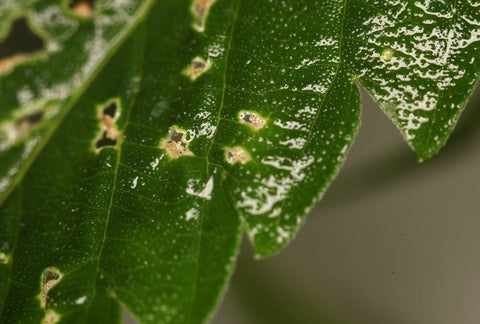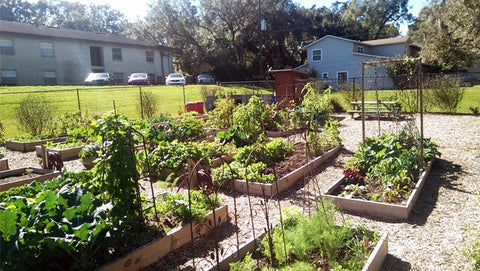Everybody loves to eat. And when we say everybody, that includes the little creepy crawlies in your garden too. They’ll keep munching on your greens until you’re left with nothing but holes in your lettuce and basil leaves. As a gardener who tends to your plants day in and day out, we know just how crazy pests and bugs can drive you when they ruin a perfectly good crop. But worry not! Because in this blog, we’ll offer you some tips on how to fight back and help you regain your garden from these pesky critters.
Prevent The Infestation
Remember that prevention is always better than a cure. So before you even have to worry about the bug infestation in your garden, make sure that it doesn’t happen in the first place. Here are some ways on how you can prevent your lovely garden from being devoured by pests.
Plant in Healthy Soil

Good soil is the foundation of any healthy, thriving garden. Since soil contains all the nutrients that your plant will absorb, it is an absolute must that you build a fertile soil environment. Studies show that the healthier your soil is, the better your plants will resist pest attacks. In addition to that, healthy soil also contains many natural enemies of insect pests such as insect predators, pathogenic fungi, and insect-parasitic nematodes.
To build healthy soil, make sure that the soil is high in organic matter because this is what provides food to the soil microbes, which compose all the good stuff that your plant will absorb. Starting a compost bin and then adding it to your garden soil will encourage a fit environment for your edible garden. Mulching or covering your soil with bark, grass cuttings, leaves, and other organic matter can also suppress weeds and maintain a steady soil temperature. More importantly, mulching can also repel aphids and thrips and reduce bug-transmitted diseases in your crops. Also, stop turning your soil! A recent study shares that over-tilling your soil can cause soil erosion and can harm all the biodiversity living inside them. Keep the soil tilling to a minimum so as not to disturb the life inside it. Instead, let the earthworms do the work of aerating your soil.
Attract Beneficial Insects
Not all bugs are out to get your garden. Some of them are there to help you decompose, pollinate, and, most importantly, eat up harmful pests. So what kind of bugs should you make friends with then? Well, ladybugs are the number one aphid eaters. An adult ladybug can eat about 50 aphids a day, and if you’re lucky enough that your ladybug decides to birth some baby bugs, each hatched larvae can eat up to 400 aphids before entering its pupal stage. Hoverflies and ground beetles also love a good aphid as a crunchy snack. Lacewings are the most effective predators you can add to your garden because they feast not only on aphids but also mealybugs, leafhoppers, caterpillars, whiteflies, and insect eggs. Parasitic wasps are also the perfect soldiers to protect your vegetable garden since they eat cabbage worms, tomato fruitworms, and corn earworms.

If your garden doesn’t have the natural biodiversity of these helpful insects, you can always purchase some at your local garden store. If you want to keep them in your garden, make sure you provide a habitable place for them to call home. We suggest planting some flowers for these insects so they can eat their pollen and nectar when your pest problem goes away.
Inspect Your Plants
Much like the temperature checks we have to go through before entering an establishment during this pandemic era, you should also inspect new plants before bringing them into your home. When you decide to purchase a new plant instead of growing them from seed, make sure you do your thorough search for any disease or pests that the plant may carry. Check under their leaves for any white, brown, or red spots, as these signs could point to an aphid, scale, or spider mite infestation. Inspect where the stem and leaves meet for any thrips hiding around. Don’t forget to brush your fingers on the potting soil to check for some possible fungus gnats lying around.
Of course, the same rule applies when you want to move a plant that’s been sitting outside into your house, especially when the fall and winter seasons come. There could be plenty of hitchhiking pests hiding in your tomatoes that will hop on to the next juicy plant they see if you don’t detect them. So always keep your eyes sharp and be on the lookout for anything strange you might see on that basil plant you want to put on your windowsill.
It’s Time To Fight Back
When you’re way past the point of preventing pests from wreaking havoc on your beloved garden, the only solution you have left is to attack these bothersome critters. But tread with caution as you strategize your game plan because bear in mind that spraying potent pesticides can kill the beneficial bugs in your garden as well. We propose that you try these less harsh measures tailored to fight each pest before resorting to harmful chemicals.
Aphids

The most common pest one might have in their growing garden would be aphids. These little pear-shaped bugs multiply at the speed of light, so it’s best to treat them straight away. If there aren’t too many, you can pick them by hand or hose them down with some high water pressure. Another effective way to treat an aphid infestation would be to spray your plant with some DIY anti-aphid spray made with a few tablespoons of liquid soap and water. Make sure to gently wipe down your plants and leaves after spraying them with the mixture. If things get worse, try using neem oil instead. Neem oil is a stronger alternative to ward of these unwanted guests.
Fungus Gnats

Fungus gnats are tiny fruit-fly sized creatures that live in the soil of your indoor plants. Since fungus gnats only lay their eggs on the top inch of the soil, you can easily remove this and replace it with some sand and gravel. Fungus gnats only thrive in moist soil, so keeping your soil dry and not overwatering your plant should keep them away. Another trick you could use is putting yellow sticky paper or fly traps on top of your soil. Gnats are attracted to the color yellow, and so if you cut these into little squares and spread them across your soil, those little guys are guaranteed to stick to them.
Spider Mites

These minuscule arachnids called spider mites love dry weather and like to hide under the leaves of your plants. If you notice that your plant is starting to have some patchy yellow spots, then it could be a sign that spider mites have been sucking at them. A proven study in 2017 suggests using a few drops of essential oils like rosemary, chamomile, and spearmint mixed with water to kill off these eight-legged creatures. A neem oil spray also works for treating spider mites. All you have to do is spray these water-oil mixtures on the affected areas and wipe them down with a piece of cloth or paper towel.
Whiteflies

Whiteflies look like itsy-bitsy moths that love to hang out under the leaves of your leaves. They often turn your leaves yellow and sometimes like to leave a black sooty mold. If your whiteflies don’t budge by hosing them down with water, try spraying them with an insecticide mix consisting of water, baking soda, dish soap, and white vinegar. You can also opt to plant marigolds beside the infested plant as this flower is known to repel whiteflies.
Caterpillars

Although caterpillars can turn into beautiful butterflies one day, these hungry worms can become your number one enemy after chowing down on the crispy lettuce you worked so hard to grow. If you like, you can pick them off from your plant one by one and release them into the wilderness so they might still turn into a fluttering butterfly one day. However, if the scenario is looking more like a caterpillar apocalypse, the most effective way to fight them off would be to treat your plants with Bacillus thuringiensis (BTK), a naturally occurring bacteria that kills caterpillars by destroying their stomach linings.
Thrips

These tiny insects that look like grains of black or brown rice love to suck out the juice from your plant’s stems. Sticky tapes will work nicely to get rid of these bad boys, as well as following any of the other advice mentioned above, like using organic insecticidal spray or hosing down with water. If you are growing outside, removing weeds and grass around the affected crop will help control your thrip problem because these critters like to live in green environments.
If the infestation is beyond the point of salvation through pruning and all the other methods we shared, then it’s time to face the music and let go of your infected plant. Put it in a bag, throw it away, or burn it if you want. Start fresh and smile. Half of the fun in gardening is learning how to keep your plant alive anyway, right? If you have any more questions on this topic, find us on Instagram or join our private Facebook group. We would be happy to start a conversation with you!









There are no comments for this article. Be the first one to leave a message!